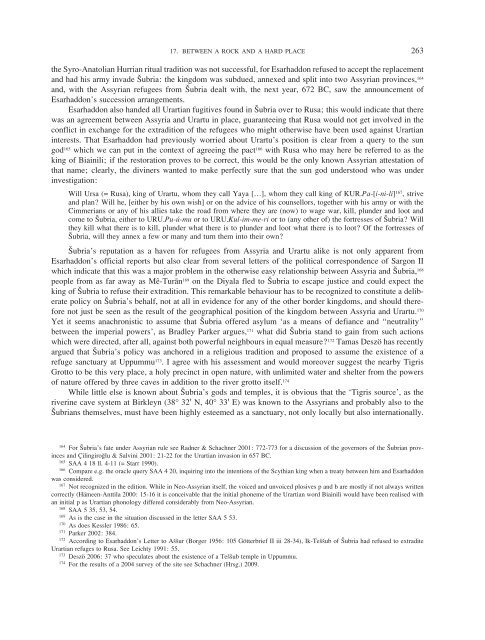Download PDF version of article - UCL
Download PDF version of article - UCL
Download PDF version of article - UCL
You also want an ePaper? Increase the reach of your titles
YUMPU automatically turns print PDFs into web optimized ePapers that Google loves.
17. BETWEEN A ROCK AND A HARD PLACE 263<br />
the Syro-Anatolian Hurrian ritual tradition was not successful, for Esarhaddon refused to accept the replacement<br />
and had his army invade Subria: the kingdom was subdued, annexed and split into two Assyrian provinces, 164<br />
and, with the Assyrian refugees from Subria dealt with, the next year, 672 BC, saw the announcement <strong>of</strong><br />
Esarhaddon’s succession arrangements.<br />
Esarhaddon also handed all Urartian fugitives found in Subria over to Rusa; this would indicate that there<br />
was an agreement between Assyria and Urartu in place, guaranteeing that Rusa would not get involved in the<br />
conflict in exchange for the extradition <strong>of</strong> the refugees who might otherwise have been used against Urartian<br />
interests. That Esarhaddon had previously worried about Urartu’s position is clear from a query to the sun<br />
god 165 which we can put in the context <strong>of</strong> agreeing the pact 166 with Rusa who may here be referred to as the<br />
king <strong>of</strong> Biainili; if the restoration proves to be correct, this would be the only known Assyrian attestation <strong>of</strong><br />
that name; clearly, the diviners wanted to make perfectly sure that the sun god understood who was under<br />
investigation:<br />
Will Ursa (= Rusa), king <strong>of</strong> Urartu, whom they call Yaya […], whom they call king <strong>of</strong> KUR.Pa-[i-ni-li] 167 , strive<br />
and plan? Will he, [either by his own wish] or on the advice <strong>of</strong> his counsellors, together with his army or with the<br />
Cimmerians or any <strong>of</strong> his allies take the road from where they are (now) to wage war, kill, plunder and loot and<br />
come to Subria, either to URU.Pu-ú-mu or to URU.Kul-im-me-ri or to (any other <strong>of</strong>) the fortresses <strong>of</strong> Subria? Will<br />
they kill what there is to kill, plunder what there is to plunder and loot what there is to loot? Of the fortresses <strong>of</strong><br />
Subria, will they annex a few or many and turn them into their own?<br />
Subria’s reputation as a haven for refugees from Assyria and Urartu alike is not only apparent from<br />
Esarhaddon’s <strong>of</strong>ficial reports but also clear from several letters <strong>of</strong> the political correspondence <strong>of</strong> Sargon II<br />
which indicate that this was a major problem in the otherwise easy relationship between Assyria and Subria, 168<br />
people from as far away as Mê-Turan 169 on the Diyala fled to Subria to escape justice and could expect the<br />
king <strong>of</strong> Subria to refuse their extradition. This remarkable behaviour has to be recognized to constitute a deliberate<br />
policy on Subria’s behalf, not at all in evidence for any <strong>of</strong> the other border kingdoms, and should therefore<br />
not just be seen as the result <strong>of</strong> the geographical position <strong>of</strong> the kingdom between Assyria and Urartu. 170<br />
Yet it seems anachronistic to assume that Subria <strong>of</strong>fered asylum ‘as a means <strong>of</strong> defiance and “neutrality”<br />
between the imperial powers’, as Bradley Parker argues, 171 what did Subria stand to gain from such actions<br />
which were directed, after all, against both powerful neighbours in equal measure? 172 Tamas Deszö has recently<br />
argued that Subria’s policy was anchored in a religious tradition and proposed to assume the existence <strong>of</strong> a<br />
refuge sanctuary at Uppummu 173 . I agree with his assessment and would moreover suggest the nearby Tigris<br />
Grotto to be this very place, a holy precinct in open nature, with unlimited water and shelter from the powers<br />
<strong>of</strong> nature <strong>of</strong>fered by three caves in addition to the river grotto itself. 174<br />
While little else is known about Subria’s gods and temples, it is obvious that the ‘Tigris source’, as the<br />
riverine cave system at Birkleyn (38° 32b N, 40° 33b E) was known to the Assyrians and probably also to the<br />
Subrians themselves, must have been highly esteemed as a sanctuary, not only locally but also internationally.<br />
164 For Subria’s fate under Assyrian rule see Radner & Schachner 2001: 772-773 for a discussion <strong>of</strong> the governors <strong>of</strong> the Subrian provinces<br />
and Çilingiroglu & Salvini 2001: 21-22 for the Urartian invasion in 657 BC.<br />
165 SAA 4 18 ll. 4-11 (= Starr 1990).<br />
166 Compare e.g. the oracle query SAA 4 20, inquiring into the intentions <strong>of</strong> the Scythian king when a treaty between him and Esarhaddon<br />
was considered.<br />
167 Not recognized in the edition. While in Neo-Assyrian itself, the voiced and unvoiced plosives p and b are mostly if not always written<br />
correctly (Hämeen-Anttila 2000: 15-16 it is conceivable that the initial phoneme <strong>of</strong> the Urartian word Biainili would have been realised with<br />
an initial p as Urartian phonology differed considerably from Neo-Assyrian.<br />
168 SAA 5 35, 53, 54.<br />
169 As is the case in the situation discussed in the letter SAA 5 53.<br />
170 As does Kessler 1986: 65.<br />
171 Parker 2002: 384.<br />
172 According to Esarhaddon’s Letter to Assur (Borger 1956: 105 Götterbrief II iii 28-34), Ik-Tessub <strong>of</strong> Subria had refused to extradite<br />
Urartian refuges to Rusa. See Leichty 1991: 55.<br />
173 Deszö 2006: 37 who speculates about the existence <strong>of</strong> a Tessub temple in Uppummu.<br />
174 For the results <strong>of</strong> a 2004 survey <strong>of</strong> the site see Schachner (Hrsg.) 2009.

















